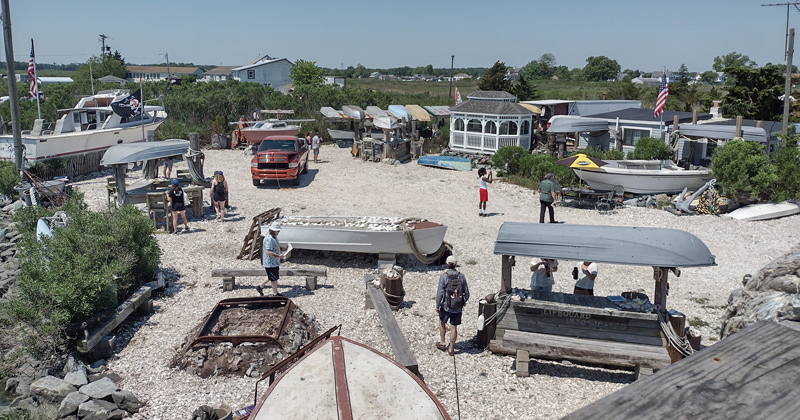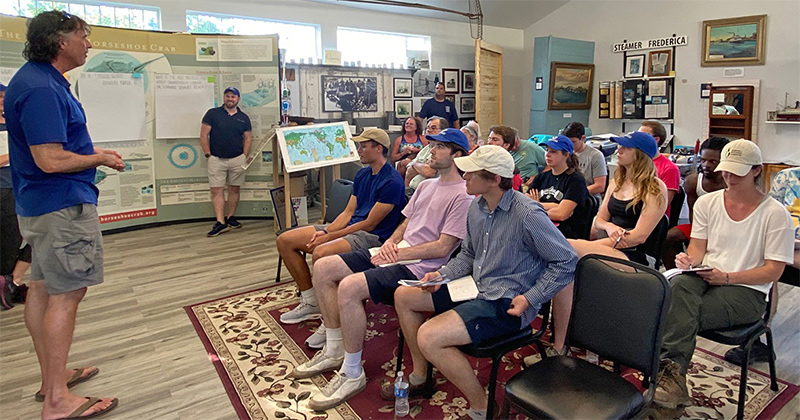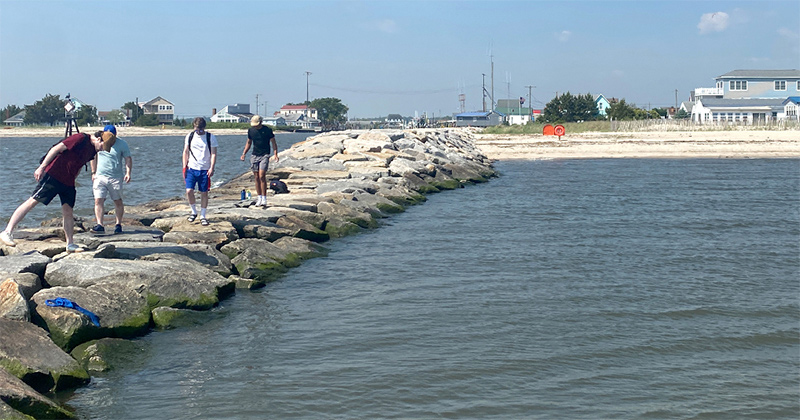


Helping build community resilience
Photos courtesy of Zach Hammaker and Leigh Muldrow June 09, 2023
The Coastal Resilience Design Studio receives awards for work with Bowers Beach
Every summer, the Coastal Resilience Design Studio (CRDS) chooses communities in Delaware to work with and, ultimately, design a community resilience plan for the area. In the summer of 2022, the CRDS focused on Bowers Beach, a coastal community in Delaware with a rich maritime history and access to the Delaware Bay.
To evaluate Bowers Beach and figure out how to best serve the community, students in the CRDS — a partnership between the Delaware Sea Grant College Program, the University of Delaware’s Sustainable Coastal Communities Initiative, and the University of Delaware Landscape Architecture Program — took an overnight trip to Bowers Beach.
During the two-days spent in Bowers Beach, the students spoke with residents, town officials and stakeholders, toured the town, and had an evening where they asked members of the community about their aspirations for the town.
Zach Hammaker, senior instructor in UD’s landscape architecture program and the principal of the CRDS, said that the overall goal of the CRDS is to help communities that might otherwise be overlooked.
“The goal is that there is a lot of funding available through different organizations and they’re all doing wonderful work, but when we look at these small, coastal towns, we’re realizing that they don’t have anyone who is helping them think about the big picture,” said Hammaker. “That’s where we come into play. We typically work with the smaller, underserved communities — those that are financially strapped or that have underrepresented populations.”
After the two days spent in Bowers Beach, students in the CRDS — who came from UD, Delaware Technical Community College (DTCC) and Wilmington University — spent the next 10-weeks researching the history of the community and working on sketches that culminated in the Bowers Resilience Plan, which was completed and presented to the community in September of 2022.
Ada Puzzo, the mayor of Bowers Beach, said it is hard to put into words how much the town benefited from the collaboration with the CRDS students.
“The participation of those students in the study, the collaboration that we had, was so significant to the town of Bowers,” said Puzzo. “I was tremendously impressed with how focused the students were and how quickly they came up with a meaningful study on coastal resilience for the town. If we had not had the CRDS students here to do that study, there are some things that absolutely would not have happened in our town that are happening and it’s quite exciting.”

For instance, Puzzo noted that one of the recommendations the CRDS students made in their coastal resilience plan was to use the silt from offshore dredging to help restore the marsh.
“Because of that idea, I fought for and submitted a proposal to our congressional delegates for funds that would be allocated to the Army Corps of Engineers so that Bowers Beach could benefit from the use of the silt,” said Puzzo. “And I got it. We were awarded $3 million. But, all of that never would have happened if the students hadn’t come.”
Not only did their work receive praise from the residents of Bowers Beach, it also received national recognition by the American Planning Association (APA) as they received the 2023 APA Sustainable Communities Division Student Award for Excellence in Sustainability for their report titled, “Adapting and Living with Changing Coastal Conditions.”
They also received an Honor Award in the Student Collaboration category from the American Society of Landscape Architects (ASLA) Pennsylvania/Delaware chapter.
“I was very excited that we got these awards,” said Hammaker. “It makes me excited for the future of CRDS and for the communities we’re working with because these national organizations are recognizing the work that our students do.”
Bowers Beach plan
The work with Bowers Beach came about through Ed Lewandowski, DESG's community development specialist and coordinator of UD's Sustainable Coastal Communities Initiative, who also serves as the community engagement lead for the CRDS. Lewandowski has conducted work in Bowers for over a decade and through his experience, he knew Puzzo.
“Ada reached out to me and said, ‘Hey, is there any way you can help us with a couple of things?’ I told her about CRDS and she said, ‘Absolutely, let’s get it going,’” said Lewandowski.
The CRDS hires an interdisciplinary team of students from across Delaware every summer whose interests range from landscape architecture, engineering, and policy to marine biology, hydrology and soil science.
“It depends on the type of project that we are going to be undertaking and who applies,” said Hammaker. “But we try to put together a holistic team of students.”
Andrew Gainey, who received his associate's degree in environmental engineering technology at DTCC before transferring to Wilmington University and receiving his bachelor's degree in environmental science and policy, worked on the Bowers Beach project and said he enjoyed the collaborative nature of the CRDS.
“It’s really important that every person has the ability to speak, brainstorm, and coagulate their ideas into the goals of a community, while also retaining the ability to express themselves through design work,” said Gainey. “I enjoyed being surrounded by so many intelligent people who taught me so much. I think that having so many disciplines in the team allowed me to express my knowledge to my colleagues knowing that I would learn just as much from them as I would doing work for any various projects. It helped me develop more confidence and more open-mindedness.”

For the Bowers Beach project, Puzzo said the town was very accommodating to the students, even arranging it so they could stay at a local Airbnb.
“They didn’t just come here, look around for a bit and go back home,” said Puzzo. “They stayed here. We wanted them to feel the town, talk to the people, see the town at high tide, see it at low tide, go to our restaurants and walk around. I think that was extremely valuable for us, without a doubt.”
The students were broken up into three groups: the marsh group, the beach and Murderkill River group, and the town center group.
The marsh group looked at the marshes on the northern and southern boundaries of the town and the impact from the New Deal Civilian Conservation Corps mosquito ditching that happened in the early 1930’s. That ditching has increased and even promoted flooding because the marshes are not working the way that they are supposed to work hydrologically or ecologically for flora and fauna.
The plan put together by the students would reestablish typical marsh processes and improve the flooding protection capacity of the marsh, while also supporting local wildlife and encouraging eco-tourism.
The beach group was primarily focused on where the sand from the beach is going and what areas of the dune system need to be restored and reinforced, looking at previous studies and discovering a point halfway up the beach where the sand drift went north instead of south. They also looked at the shape of the jetties in the area, and used historical aerial images of the shoreline and mapped the shoreline change from the early 1900’s to the present day. They were also taking into account the horseshoe crabs, red knots, and other species of concern in the area.
Their recommendations came from an idea to bring the shoreline back to what it was in the early 1900s when the shoreline was creating protection and holding sand in place.
“We recommended some breakwaters, a living shoreline, and increasing the length and height of the current jetties that were there,” said Hammaker. “Specifically, we recommended a breakwater at that nodule point so that it would dissipate wave energy.”
The town center group focused on anything related to the town itself. Besides a large parking lot in the middle of the town, Bowers Beach does not have a core town center. One of the aims was to try and understand when the town gets visitors and has large events, how they could connect the different areas of town and also address issues like storm water and increased flooding from sea level rise and large storms.
In addition, they looked at a number of different low impact development strategies and stormwater retention strategies through green infrastructure, as well as opportunities to plant native plant species and increase plant diversity to absorb stormwater. They also worked on trails that would go through the marsh and connect to the parking lot, as well as provide accessibility to the beach and other areas of town that meet standards of the Americans with Disabilities Act (ADA) .
Presenting to the community
The students presented their recommendations to the community and explained how they would evolve over time.
Gainey said because the CRDS does so much work focusing on the input of the community and maintaining the character of existing communities, the resulting products can be used as a catalyst for change.
“The work that's done can be shared, discussed, analyzed, and delivered to capture the attention of people and organizations which could be a stepping stone in having the community-based ideas of the CRDS implemented,” said Gainey. “Part of what is so exciting about delivering a product is the attention and traction the projects receive after. When people are discussing ideas and recommendations, the conversations could be a point of traction for future implementation.”
The plan put together by the CRDS was used by the studio and UD’s Joseph R. Biden, Jr. School of Public Policy and Administration and their Grant Assistance Program to collaborate with the town to create an application for a feasibility study on the conceptual designs prepared by the students.
While they are still waiting to hear about funding for the proposal, Hammaker said that the work the CRDS did with Bowers Beach could serve as a model moving forward.
“It’s a new strategy for us as a studio,” said Hammaker. “We’re starting to think about, ‘Ok, can we start going after funding for the next stage of planning and design.’ We understand and recognize there is a private market out there, and we don’t want to be in competition with them, but we do feel like the communities are getting a comprehensive vision that allows them to prioritize their needs.”
As for the summer of 2023, the CRDS has projects lined up in Slaughter Beach and with the town of Milton.
“I’m expecting a really successful summer for the program,” said Lewandowski. “I think the national and state recognition really speaks to its effect—especially when you have pros that are judging the work that we’re doing and awarding it.”
Contact Us
Have a UDaily story idea?
Contact us at ocm@udel.edu
Members of the press
Contact us at 302-831-NEWS or visit the Media Relations website

